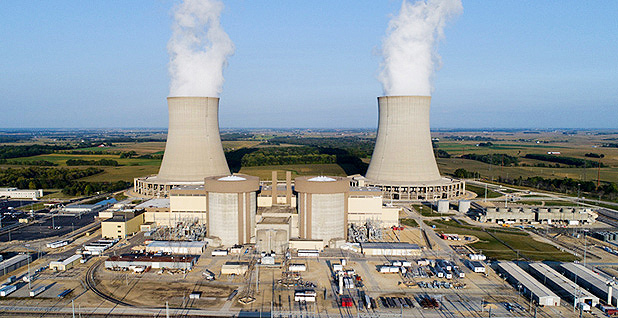Salem Nuclear Power Plant as photographed from Delaware Bay.
When a nuclear power plant closes, here is what happens:
Thousands of people lose their jobs. The local economy nosedives. Air pollution increases. Reliance on natural gas, often bought from out-of-state, goes up. Electricity on the grid becomes less reliable with the loss of the most reliable source of power. And electric prices can even rise.
An illustration of WIPP’s Safety Significant Confinement Ventilation System, expected to be completed in 2025. Image: DOE
Nuclear Waste Partnership (NWP), the management and operations contractor for the Department of Energy’s Waste Isolation Pilot Plant in southeastern New Mexico, announced that it has awarded a subcontract valued at approximately $163 million to The Industrial Company (TIC) to complete the construction of the transuranic waste repository’s Safety Significant Confinement Ventilation System (SSCVS).
Diver John Lehto (right) receives final instructions from Carter Thomas before entering a 300,000-gallon water tank at the Hanford Site. Lehto and Thomas are employees of Hanford Site subcontractor Associated Underwater Services. Photos: DOE EM
The Department of Energy’s Richland Operations Office contractors Central Plateau Cleanup Company (CPCCo) and Hanford Mission Integration Solutions (HMIS) teamed up recently to dive into inspection and maintenance activities at the Hanford Site in Washington state.
Project video: View this video for sights and sounds from this unique project.
Fully ceramic microencapsulated fuel. Image: USNC
Canadian Nuclear Laboratories (CNL) announced last week that it has fabricated fully ceramic microencapsulated (FCM) fuel pellets, a proprietary reactor fuel designed by Ultra Safe Nuclear Corporation (USNC) for its Micro Modular Reactor (MMR). The FCM project, funded through the Canadian Nuclear Research Initiative (CNRI), represents the first time that tristructural isotropic (TRISO) fuel has been manufactured in Canada, according to CNL.
A screenshot from the Kurzgesagt YouTube video
The German animation studio Kurzgesagt released a new video to its English YouTube channel last week to answer the question, “Do we need nuclear energy to stop climate change?” The studio’s channel on YouTube is self-described as a small team working to make science look beautiful. Its videos discuss a variety of scientific, technological, philosophical, and psychological questions, and it has more than 14 million subscribers. The channel recently discussed the question of deaths caused by radiation—spoiler alert, nuclear is among the safest of all energy production.
Waste handlers take radiological readings as a crane lifts containers from a TRUPACT-II cask in the contact-handled waste bay at WIPP. Photo: DOE
The Waste Isolation Pilot Plant in southeastern New Mexico is once again accepting shipments and processing transuranic waste following a two-month annual maintenance outage. According to the Department of Energy, WIPP is back to accepting five waste shipments per week, with post-pandemic plans to increase shipments to 10 per week.
Alberta Premier Jason Kenney at an online event on April 14, after signing an agreement on small modular reactor development. Photo: Chris Schwarz/Government of Alberta
Alberta Premier Jason Kenney has added his signature to a memorandum of understanding on small modular reactor development that was signed in 2019 by the premiers of New Brunswick, Ontario, and Saskatchewan. Kenney signed the document last week at a virtual event that also promoted the release of Feasibility of Small Modular Reactor Development and Deployment in Canada—a study formally requested as part of the MOU.
Indian Point nuclear power plant in Buchanan, N.Y.
The State of New York will withdraw its lawsuit against the transfer of Indian Point’s license to Holtec International for decommissioning under a provisional agreement signed on April 14. In exchange, Holtec has agreed to maintain a minimum of $400 million in Indian Point’s decommissioning trust fund for the next 10 years.
April 16, 2021, 2:59PMUpdated April 19, 2021, 10:56AMNuclear News The Byron nuclear plant is currently slated for permanent closure in September. Photo: Exelon
A research and consulting firm hired by Illinois governor J. B. Pritzker’s administration to scrutinize the financial fitness of Exelon’s Byron and Dresden nuclear plants approves of limited state subsidies for the facilities, according to a redacted version of the firm’s report made available yesterday.






 Listed below are the ANS professional divisions’ 2021–2022 officers and newly elected Executive Committee members. All terms begin during the 2021 ANS Virtual Annual Meeting in June. (Executive Committee members whose three-year terms are continuing are not included.)
Listed below are the ANS professional divisions’ 2021–2022 officers and newly elected Executive Committee members. All terms begin during the 2021 ANS Virtual Annual Meeting in June. (Executive Committee members whose three-year terms are continuing are not included.)












